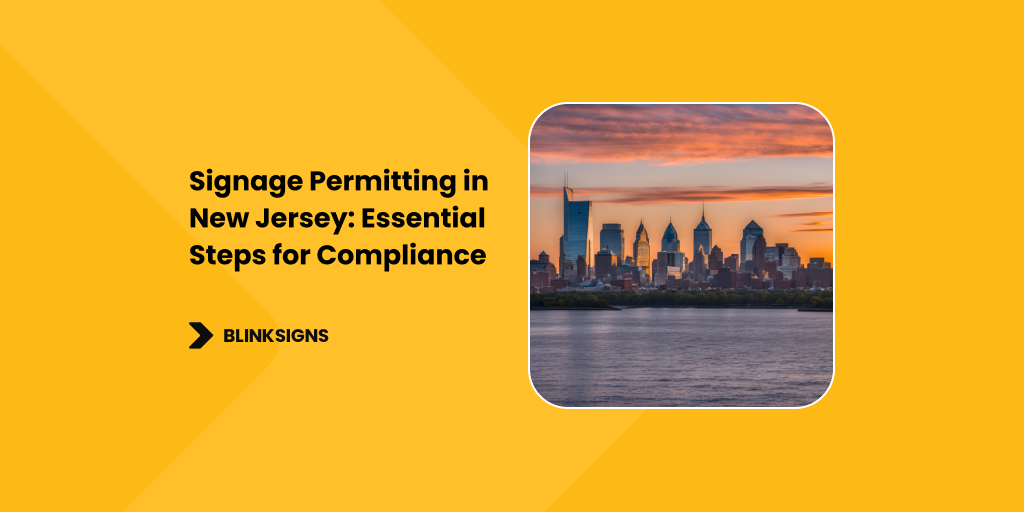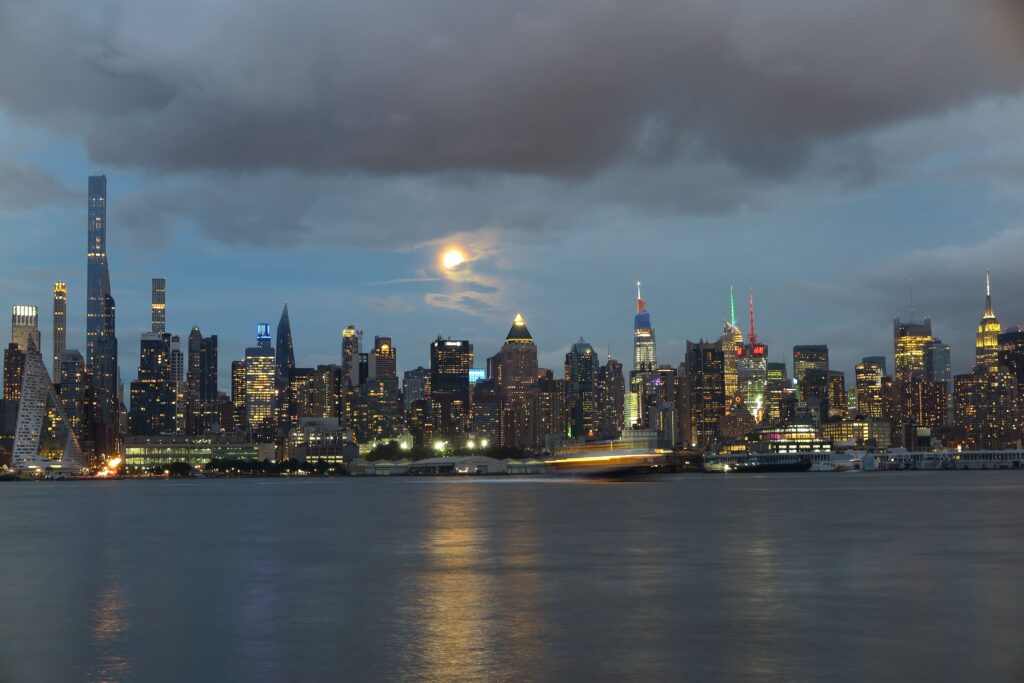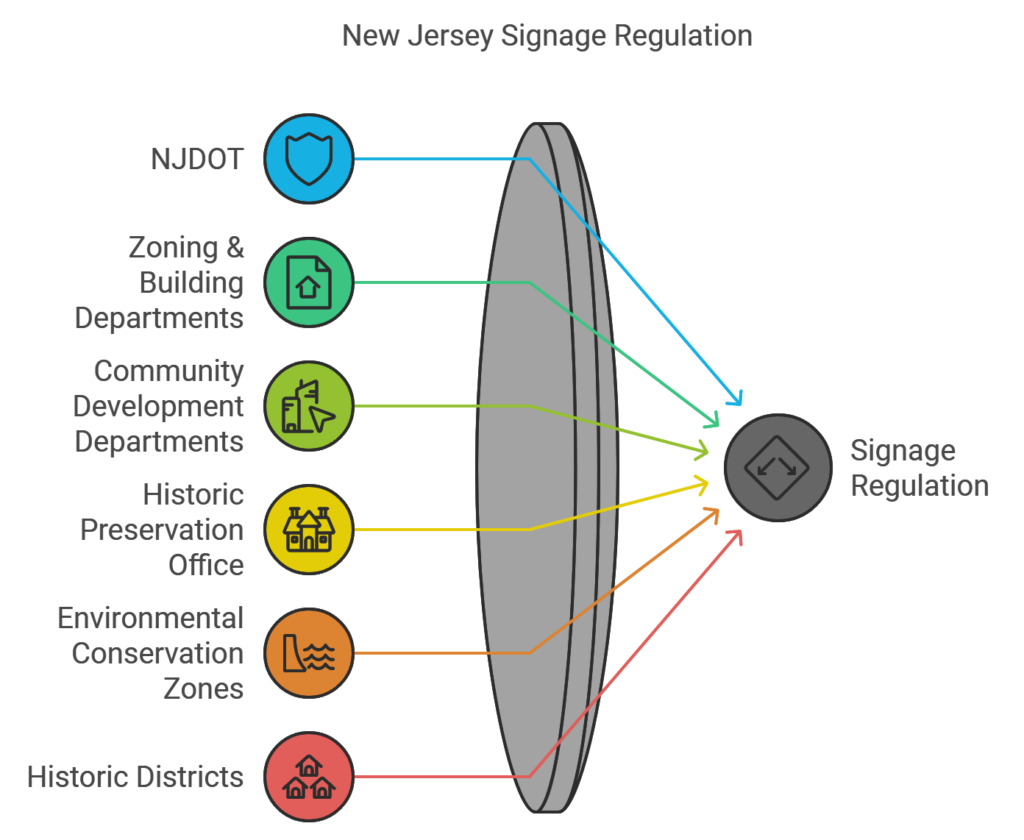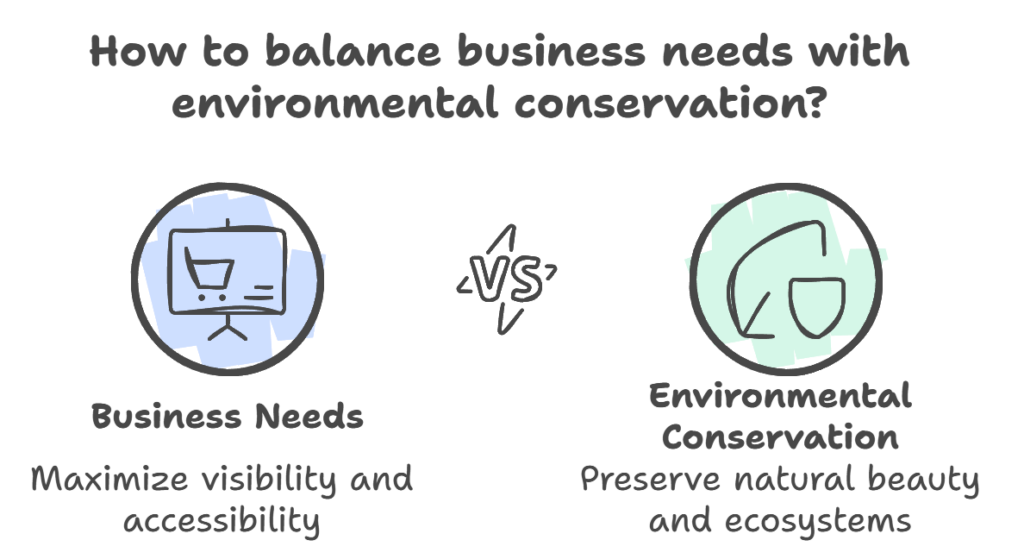
Signage Permitting in New Jersey: Essential Steps for Compliance
Why Signage Permitting is Essential in New Jersey
In New Jersey, signage is vital to the urban landscape, significantly boosting business visibility, shaping aesthetic appeal, and enhancing community character. For businesses, effective signage is often the first step to catching a customer’s eye and establishing a presence in their community. However, achieving this while adhering to New Jersey’s stringent regulations can be challenging.
This guide is designed to walk you through New Jersey’s signage permitting process, offering insights to ensure your signage stands out and complies with local, county, and state regulations.

beautiful-Manhattan-night-view-and-moon-seen-from-new-jersey (1)
Understanding Sign Permits and Regulatory Authorities in New Jersey
Understanding Sign Permits: Their Purpose and Importance in New Jersey
Sign permits are essential approvals of municipalities and state agencies mandated to maintain New Jersey’s safety, design, and community aesthetics standards. A sign permit confirms that signage is structurally sound and visually compliant and ensures it enhances the surrounding urban and suburban landscapes. New Jersey regulatory bodies enforce permit requirements to prevent hazards, uphold community standards, and foster cohesive, visually appealing environments throughout cities and towns.
Primary Regulatory Authorities
New Jersey’s signage regulation includes the NJDOT (responsible for signage along state highways), local zoning and building departments, community development departments, and the New Jersey Historic Preservation Office. These agencies work together to monitor signs’ impact on safety, aesthetics, and environmental conservation, especially in Environmental Conservation Zones and Historic Districts.

New Jersey Signage Regulation
Legal Basis for Sign Regulation
Signage regulations in New Jersey are based on municipal codes, zoning ordinances, and state-level requirements, such as the New Jersey Outdoor Advertising Act. This legal framework balances business needs with community standards, protects public safety, promotes order, and maintains scenic views along highways and scenic routes.
Types of Signage and Their Specific Permitting Requirements
Permanent vs. Temporary Signage
Permanent signage (like freestanding and facade signs) serves long-term business identification. In contrast, temporary signage (like banners, A-frames, and real estate signs) is typically used for promotions or events and is restricted by time limits and placement rules.
Common Sign Types and Compliance Standards
Each type of signage in New Jersey has its specific regulations:
| Type of Signage | Description | Size Restrictions | Height Restrictions | Illumination Standards | Special Requirements |
| Wall Signs | Attached to the exterior wall of a building | Typically limited to a percentage of wall area | Usually restricted to building height | Non-glare may require dimming after-hours | Must match the building’s architectural style; requires Design Approval in historic districts |
| Freestanding Signs | Stand-alone signs not attached to buildings | Varies by zoning district | Often limited to 15-20 feet in commercial zones | Illuminated versions require shielding to prevent glare | Setbacks from property lines; extra review for signs near residential areas |
| Monument Signs | Low-profile, ground-mounted signs | Limited to 10-15 sq. ft. in residential areas | Typically, no taller than 6-8 feet | Internally illuminated; brightness restrictions apply | Requires landscaping around base; prohibited in certain environmental zones |
| Pylon Signs | Tall signs supported by poles, often used for highway visibility | Larger in commercial zones, max size regulated | Heights of up to 30 feet allowed on highways | High-intensity lights are often restricted to specific hours | Requires highway setback by NJDOT regulations |
| Digital Billboards/EMCs | Electronic displays for dynamic messaging | Regulated based on traffic visibility impact | Maximum 15-20 feet in city centers | Brightness capped typically dimmed at night | Message frequency is regulated (e.g., every 8 seconds); prohibited in residential and protected scenic zones. |
| Temporary Signs | Short-term signs like banners, event signs, or A-frame signs | Usually capped at 32 sq. ft. | Must be easily removable | Typically non-illuminated | Duration limits (e.g., 30 days); specific placement restrictions based on pedestrian and vehicular traffic flow |
| Directional and Wayfinding | Signs that assist with navigation, such as arrows or site maps | Generally small; varies by site needs | Typically low to ground | Non-illuminated or low-light options preferred | Must meet ADA accessibility standards for readability |
| Awning Signs | Signs attached to the face or side of an awning | Limited to a percentage of awning surface area | Must not extend above the awning | Low-light sources recommended | Requires permit if illuminated; must not encroach on public right-of-way |
| Window Signs | Signs placed directly on or within windows | Size restricted to a percentage of window space | No specific height as they’re window-bound | Non-illuminated; glare prevention recommended | Permits are required if more than 25% of the window is occupied, and they are restricted in historic and environmentally protected zones. |
| Real Estate and Construction Signs | Temporary signs for properties for sale, lease, or under construction | Capped at 6-8 sq. ft. for residential areas | Usually under 6 feet | Non-illuminated | Must be removed within 7 days of sale/lease completion or project completion |
Prohibited Signs in New Jersey
Sure signs, like flashing signs, excessively bright digital billboards, and extensive electronic displays, are prohibited in specific areas to prevent driver distraction and maintain New Jersey’s aesthetic standards. Additionally, signs near scenic byways and Environmental Conservation Zones are often subject to stricter controls to protect natural beauty.
Step-by-Step Guide to the New Jersey Sign Permitting Process
Application Preparation and Submission
Gather essential documents, including site plans, elevation drawings, and specifications for sign height, setbacks, and electrical permits (if illuminated). Completing the Sign Permit Application accurately is critical to avoid delays.
Planning Board and Architectural Review Board Review
Applications undergo a detailed review by local planning boards, especially in districts with strict design standards. Approvals for signs in Historic Districts or areas overseen by Architectural Review Boards focus on maintaining architectural harmony and compliance with historic preservation guidelines.
Permit Fees and Additional Costs
Permit fees vary based on sign type and location. Expect additional costs, such as inspection fees, bond requirements, and renewal fees for longer-lasting signs.
Final Inspection and Permit Placard Display
Once approved, signs are inspected to ensure compliance with NJ Municipal Code standards. Displaying the permit placard is mandatory to confirm compliance and avoid potential penalties.
City and Township-Specific Signage Requirements Across New Jersey
This table includes essential requirements, specific regulations, and considerations for prominent cities and townships.
| City/Township | Primary Regulatory Body | Height & Size Restrictions | Illumination Rules | Additional Considerations |
| Cherry Hill Township | Cherry Hill Zoning Department, Community Development Dept. | Max height of 20 feet for freestanding signs; area limit of 40 sq ft | Illumination is only permitted from 6 AM to 10 PM | The historical district requires design approval from the Architectural Review Board. |
| Jersey City | Jersey City Planning Board, Zoning Department | Freestanding signs are limited to 25 feet; wall signs are limited to 15% of the facade area | Digital signs must comply with brightness limits | Additional requirements in Waterfront and Historic Preservation zones |
| Madison Borough | Madison Borough Zoning Dept., Planning and Development | Monument signs capped at 8 feet; wall signs max 10% of the facade | Limited to ambient lighting; no digital displays | Permits required for signs in Conservation and Residential Zones |
| Newark | Newark Planning Board, Zoning and Land Use Department | Billboard height max 40 feet; on-premise signs 15% of facade area | Brightness limits on illuminated signs near residential areas | Stringent rules for signs in historic districts; no flashing signs allowed |
| Hoboken | Hoboken Zoning Department | Freestanding signs capped at 15 feet; window signs max 20% of window area | Illumination prohibited between 11 PM and 6 AM | Waterfront district has unique aesthetic standards; historic zones require specific material use. |
| Paterson | Paterson Zoning and Planning Department | Max height for signs near highways: 30 feet; wall signs 20% of the building facade | LED signs must not exceed 0.3-foot candles in brightness | Industrial zone allows larger freestanding signs; permits required for illuminated signage |
| Trenton | Trenton Zoning Department, Building and Inspections | Monument signs are limited to 10 feet; max area 50 sq ft | Digital signs are limited to static images only | Downtown Trenton has aesthetic guidelines for signage styles and additional permits for the historic district. |
| Atlantic City | Atlantic City Zoning Board, Planning Department | Billboards are limited to 35 feet; the casino zone allows up to 50 feet | Casino zone permits 24-hour illumination for digital signs | Casino districts have unique sign allowances, strict regulations near residential areas |
| Camden | Camden Building Dept., Zoning and Planning | Max height 25 feet for freestanding signs; wall signs 10% of the facade | Prohibited from flashing near schools or parks | Permits required in redevelopment zones; restrictions on sign placement near public landmarks |
| Princeton | Princeton Planning Board, Zoning Department | Max height 12 feet for freestanding signs; wall signs 15% of facade area | Only indirect lighting is permitted; no digital signs | Specific regulations for signs near Princeton University; historic area limitations on material and color |
| Westfield | Westfield Zoning and Building Dept., Historic Commission | Monument signs capped at 6 feet; window signs max 20% of window | Limited to external, soft lighting | Historic district requires commission approval; size limits on signs in residential neighborhoods. |
| Elizabeth | Elizabeth Planning Board, Zoning Division | Wall signs are 15% of the building facade; the max height for freestanding signs is 25 feet. | Digital signs are restricted to commercial zones only | Special permits are required for the downtown area; additional signage rules near Elizabeth River Parkway |
| Edison Township | Edison Planning Board, Zoning and Code Enforcement | Freestanding signs max 20 feet; area limit 50 sq ft | No flashing or animated lighting is allowed | Industrial zones have higher size allowances and additional regulations near schools and parks. |
| Woodbridge Township | Woodbridge Zoning and Planning Dept. | Freestanding signs capped at 18 feet; wall signs max 10% of the facade | No LED lighting near residential areas | The business district has specific design standards and separate permits for temporary signage. |
| Clifton | Clifton Building Dept., Planning and Zoning | Billboard height 30 feet; wall signs limited to 15% of facade area | Prohibited from flashing within 500 ft of residences | Industrial areas allow larger signs; extra restrictions in residential neighborhoods |
| Union City | Union City Zoning and Code Enforcement | Max height for freestanding signs 12 feet; area limit of 40 sq ft | Limited to ambient or low-intensity lighting | Additional restrictions in scenic areas; historic district requires approval for all permanent signs |
| Parsippany-Troy Hills | Parsippany Planning Dept., Zoning and Building | Wall signs max 10% of the facade; freestanding signs up to 15 feet | Digital displays are allowed only with zoning approval | Specific aesthetic guidelines in corporate business parks; residential zones restrict illuminated signs |
| Fort Lee | Fort Lee Zoning and Planning Board | Max height 25 feet for freestanding signs; wall signs limited to 15% of the building facade | Digital and illuminated signs are limited to business zones | Strict requirements near George Washington Bridge and scenic zones |
| Morristown | Morristown Zoning Dept., Community Development | Monument signs capped at 8 feet; wall signs max 10% of the facade | Ambient lighting only in residential zones | Historic district requires permit review and restrictions on color and material in certain zones. |
Zoning and Land Use Requirements for New Jersey Signage
Understanding Zoning Ordinances and Zoning Departments
Local zoning ordinances dictate signage placement, size, height restrictions, and setback requirements based on area zoning. Residential, commercial, and environmentally sensitive areas may have distinct requirements.
Environmental Conservation Zones
Signage must align with conservation goals in eco-sensitive areas, using low-impact lighting and eco-friendly materials that protect natural surroundings. Restrictions also limit excessive illumination to avoid light pollution.
Historic District Regulations
Signs in historic areas are subject to additional scrutiny by Historical Commissions to preserve architectural heritage. These regulations control design elements like materials, colors, and size to ensure the sign harmonizes with the surrounding historical setting.
Sign Variance and Appeal Process in New Jersey
When is a Sign Variance Required?
A variance is required when a proposed sign does not meet local zoning code standards, such as exceeding height limits or being closer to residential areas than permitted.
Applying for a Variance
The process involves submitting a variance request to the Planning Board, accompanied by a justification for why the sign needs an exemption. Proper documentation, including impact assessments, enhances the likelihood of approval.
Appeal Process for Permit Denials
Businesses may appeal to the Board of Zoning Adjustment if a sign permit is denied. Successful appeals generally include revised plans that align more closely with local standards.
Compliance Standards and Final Inspection for New Jersey Signage
Ongoing Compliance and Maintenance Standards
Maintaining sign integrity through regular inspections ensures ongoing compliance with zoning and municipal code standards. Structural and electrical upkeep is particularly important for illuminated or digital signage.
Final Inspection Requirements
Before final approval, a city inspector checks compliance with local building and zoning codes. Passing this inspection is essential to avoid potential penalties for non-compliance.
Consequences of Non-Compliance
Failure to comply with signage standards can lead to fines, mandatory removal, and business disruptions. Regular maintenance and adherence to zoning codes can prevent costly issues.
Timeframe and Permitting Delays
Expected Timeline for Permitting
Permit approval in New Jersey can take several weeks to several months, depending on the complexity of the signage and the area’s regulatory requirements.
Factors Causing Delays
Delays may result from incomplete documentation, application errors, or additional reviews in historic districts. In some cases, public input or community feedback can also impact approval timelines.
Strategies to Expedite Permitting
Working with a professional signage service, preparing complete documentation, and engaging early with zoning departments can help businesses navigate the permitting process more efficiently.
Community Feedback and Public Hearings for High-Impact Signs
Public Input in High-Visibility Areas
Community feedback is often required for signage in high-traffic areas or near residential zones, especially when proposing large, illuminated, or digital signs.
Public Hearing Process
Public hearings may be required to gather community input for specific sign types. Preparing visuals, justifications, and testimonials can strengthen support for approval.
ADA and Accessibility Standards for Signage in New Jersey
ADA Compliance Requirements
Public signage in New Jersey must meet ADA standards, including Braille, raised text, and clear character contrast.
Visibility and Readability Standards
Sign readability standards dictate font size, spacing, and placement to ensure accessibility for individuals with visual impairments.
Inspection for Accessibility Compliance
Local agencies conduct inspections to enforce ADA standards, requiring compliant signage for accessible, inclusive business environments.
Environmental and Aesthetic Standards for Signage in New Jersey
Light Pollution and Illumination Controls
New Jersey municipalities enforce regulations to prevent light pollution, particularly in residential and scenic areas. Signage illumination must be controlled, especially for digital billboards and Electronic Message Centers (EMCs), to ensure it does not disturb nearby neighborhoods or contribute to excessive brightness in natural zones.
Eco-Friendly Signage Materials
Many New Jersey zoning boards encourage businesses to use sustainable materials for outdoor signage, such as recycled metals, low-energy LED lighting, and materials resistant to environmental wear. Eco-friendly materials reduce the environmental impact and align with New Jersey’s commitment to sustainability.
Design Standards in Historic and Scenic Areas
Historic districts and scenic areas in New Jersey have strict aesthetic guidelines, overseen by Historical Commissions and zoning boards, to maintain the unique charm of locations like Cape May and Princeton. These standards often require signage to be understated, with natural tones and minimal lighting to preserve the area’s aesthetic. Approval of signage that blends with the environment is crucial for businesses in protected or scenic zones.
Financial and Tax Implications for Signage in New Jersey
Tax Responsibilities for Permanent Signage
In New Jersey, permanent signage, such as large freestanding signs and billboards, is often subject to property tax, which varies by municipality. These taxes are typically assessed based on the sign’s size, type, and location and are managed by local tax assessor’s offices.
Tax Deductible Expenses
Businesses may be able to deduct expenses associated with signage, including permit fees, renewal costs, and maintenance expenses. Deductions for signage upkeep, like replacing LED lights or repainting facades, help businesses manage long-term costs while keeping signage compliant and in optimal condition.
Cost-Efficient Signage Strategies
Investing in compliant, high-quality signage can yield long-term savings. Using durable, weather-resistant materials minimizes replacement costs, while compliance with energy-efficient lighting standards helps reduce operational expenses. These strategic choices ensure signage longevity and reduce the need for frequent updates.
Special Considerations for Historic and Protected Areas in New Jersey
Historic District Requirements
Signs in New Jersey’s historic districts, such as those in Montclair or Morristown, must adhere to strict design, size, and material standards enforced by local Architectural Review Boards. These areas typically require materials, colors, and scale approval to ensure they complement the historical character.
Environmental and Protected Zones
Environmental Conservation Zones and other protected areas enforce additional restrictions on signage to preserve New Jersey’s natural beauty. Businesses near parks or coastal regions may face stricter lighting, height, and material choice guidelines to limit environmental impact.

environmental conservation
Preservation and Aesthetic Compliance
Maintaining New Jersey’s heritage and scenic appeal is a priority in protected areas. Businesses in historic zones are encouraged to use non-reflective materials, muted colors, and traditional design elements. Compliance with these standards preserves aesthetic harmony, and failing to do so could lead to permit revocation.
FAQs
- What makes BlinkSigns the right choice for navigating New Jersey’s signage regulations?
BlinkSigns is your trusted partner for New Jersey signage. We simplify complex permitting, handling every step from application to compliance checks to ensure your signage meets all regulations. - How does BlinkSigns handle permit applications for large signs in New Jersey?
BlinkSigns manages comprehensive permitting for large signs, like digital billboards and pylon signs, ensuring compliance with NJDOT regulations, including visibility, safety, and location requirements. - Can BlinkSigns help with approval for signage design for historic districts?
BlinkSigns specializes in designing compliant signage for New Jersey’s historic districts. We work closely with local Historical Commissions to create approved, aesthetically fitting signage. - How does BlinkSigns ensure ADA compliance for signage in public spaces?
BlinkSigns provides fully ADA-compliant signage, including non-glare finishes, proper height placements, and Braille integration, ensuring accessibility standards are met for public spaces. - Does BlinkSigns manage variances for signs that don’t meet New Jersey’s standard regulations?
Absolutely. BlinkSigns handles variance applications, coordinating with local zoning boards to secure approval for signs that need exceptions to New Jersey’s standard signage regulations. - Can BlinkSigns assist with environmentally friendly signage solutions?
BlinkSigns offers eco-friendly signage that uses sustainable materials and energy-efficient lighting that meets New Jersey’s environmental standards, reduces light pollution, and conserves energy. - How can BlinkSigns help reduce costs related to signage permitting?
BlinkSigns maximizes cost-efficiency with strategic design and materials that meet New Jersey standards. We also help identify tax deductions for signage maintenance and compliance expenses. - What are BlinkSigns’ best practices for ongoing sign maintenance in New Jersey?
BlinkSigns offers maintenance plans, including routine inspections for illuminated signs, to ensure compliance and avoid costly repairs. Regular upkeep supports long-term regulatory adherence. - Does BlinkSigns handle permit renewals and updates?
Yes, BlinkSigns manages permit renewals, ensuring your signage complies with current regulations. We track renewal dates to avoid lapses and keep your signage up to code. - How does BlinkSigns streamline signage approval in busy cities like Jersey City or Newark?
BlinkSigns accelerates the approval process in high-traffic areas like Jersey City and Newark by leveraging local knowledge and zoning connections, reducing delays, and ensuring compliance. - Can BlinkSigns help if my sign is cited for non-compliance?
Yes, BlinkSigns assists with non-compliance issues by coordinating modifications, re-inspections, or re-submissions to bring your signage back into compliance with New Jersey’s standards. - How does BlinkSigns handle temporary signage permits in New Jersey?
BlinkSigns secures permits for temporary signs, ensuring your signage adheres to duration and placement rules in New Jersey, enabling effective, compliant promotional displays.
Conclusion: Achieve Compliant, Effective Signage in New Jersey with BlinkSigns
Navigating signage permitting in New Jersey can be complex, with various requirements, from local zoning laws to state-level regulations. By following New Jersey’s signage permitting guidelines, businesses can create signage that is effective in attracting customers and compliant with regulations that protect public safety and community aesthetics.
BlinkSigns specializes in simplifying the signage permitting process for New Jersey businesses, from preparing applications to meeting specific local requirements in cities like Jersey City, Cherry Hill, and Madison Borough. With a deep understanding of New Jersey’s regulatory landscape, we ensure that your signage meets all compliance standards while capturing the attention of your target audience.
Contact BlinkSigns today to bring your signage vision to life with confidence and compliance, enhancing your business’s presence across the Garden State.